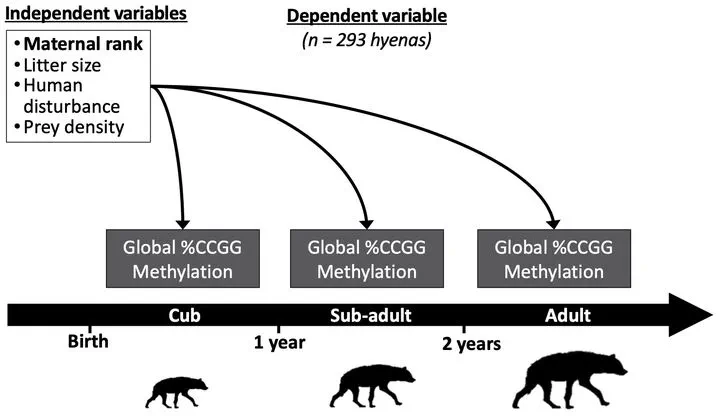Early life social and ecological determinants of global DNA methylation in wild spotted hyenas
Sep 10, 2019·
,
,
,
,
,
,
,
·
0 min read
Zachary M. Laubach
Christopher D. Faulk
Dana C. Dolinoy
Luke Montrose
Tamara R. Jones
Donna Ray
Malit O. Pioon
Kay E. Holekamp

Abstract
Environmental factors early in life can have lasting influence on the development and phenotypes of animals, but the underlying molecular modifications remain poorly understood. We examined cross‐sectional associations among early life socioecological factors and global DNA methylation in 293 wild spotted hyenas (Crocuta crocuta) in the Masai Mara National Reserve, Kenya, grouped according to three age classes (cub, subadult and adult). Explanatory variables of interest included annual maternal rank based on outcomes of dyadic agonistic interactions, litter size, wild ungulate prey density and anthropogenic disturbance in the year each hyena was born based on counts of illegal livestock in the Reserve. The dependent variable of interest was global DNA methylation, assessed via the LUminometric Methylation Assay, which provides a percentage methylation value calculated at CCGG sites across the genome. Among cubs, we observed approximately 2.75% higher CCGG methylation in offspring born to high‐ than low‐ranking mothers. Among cubs and subadults, higher anthropogenic disturbance corresponded with greater %CCGG methylation. In both cubs and adults, we found an inverse association between prey density measured before a hyena was 3 months old and %CCGG methylation. Our results suggest that maternal rank, anthropogenic disturbance and prey availability early in life are associated with later life global DNA methylation. Future studies are required to understand the extent to which these DNA methylation patterns relate to adult phenotypes and fitness outcomes.
Type
Publication
Molecular Ecology